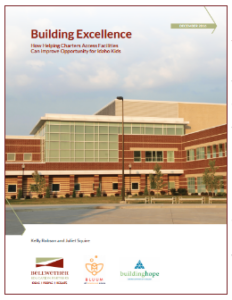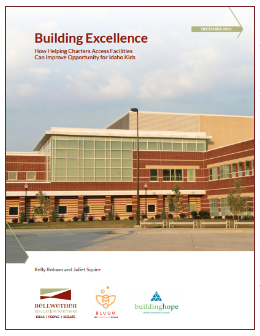Finding and financing school facilities continues to be a major barrier for charter schools. Many states have created programs to help ease the burden, including loan programs, per-pupil facilities allocations, and provisions to help charters access unused facilities.
But no state has fully equalized facilities access for charter schools. Idaho is no exception.
 In a new report, Juliet Squire and I present the results of a survey of Idaho’s charter school leaders. We asked charter leaders about their facilities-related expenditures, and what amenities (like auditoriums, gyms, and libraries) their facilities have. We then collected data points like the square footage and seat capacity of schools’ current facilities.
In a new report, Juliet Squire and I present the results of a survey of Idaho’s charter school leaders. We asked charter leaders about their facilities-related expenditures, and what amenities (like auditoriums, gyms, and libraries) their facilities have. We then collected data points like the square footage and seat capacity of schools’ current facilities.
These data enabled us to quantify the stark discrepancy in access to state and local facilities funding sources between district and charter schools. On average, districts have access to approximately $1,445 per pupil of state and local funding. Charter schools get less than one-quarter this amount: $347.
Organizations like Building Hope and foundations like the J.A. and Kathryn Albertson Family Foundation (a Bellwether client) have helped close this gap for some charter schools. Others have been able to access tax-exempt bonds through the Idaho Housing and Finance Association. And the state has recently enacted a debt reserve fund and a small per-pupil facilities allocation (about $335 this year). Even so, most charter schools rely heavily on their per-pupil funds to cover facilities-related expenses.
The data from our survey suggest that, despite these avenues for facilities funding, accessing financing remains a major barrier to securing an adequate facility. Moreover, charter leaders struggle to find property suitable for their school, and often have to make significant tradeoffs — like forgoing a gymnasium or using cheaper materials to build. When facilities are inadequate, charter leaders indicate that it is difficult to provide the educational programming they envision for their students.
But perhaps the most telling finding is that, despite the financial constraints they face, charter leaders are doing extraordinary work securing facilities for their schools. In fact, they are able to build schools at a fraction of what traditional school districts spend.
We compared the per-pupil charter and district facility costs in several Idaho towns (all in 2016 dollars). In Idaho Falls, Alturas International Academy, which opened this fall, is currently renovating an old public school building for approximately $12,000 per seat. The local school district, on the other hand, is considering a $90 million bond to upgrade its two high schools — at a cost of more than $37,200 per student. In southern Idaho, recent renovations to Jerome High School cost approximately $18.46 million, or $19,300 per enrolled student. But local charter school Heritage Academy purchased a facility from a private school for $374,000, about $2,600 per enrolled student.
These glaring examples clearly demonstrate the work that charter school leaders are doing to provide a facility for their schools despite financial constraints.
But the current facilities financing landscape is putting the brakes on new or expanding charter schools. Currently, about 6,000 students are on waitlists for charter schools across the state. And Idaho is expected to add nearly 22,000 new prek-12 students by fall 2022. Charter schools can help ensure these young people have access to a high-quality education, but only if they new schools are able to open and existing schools can expand.
There are there three possible avenues for policymakers to help make this a reality:
- Expand existing programs, namely the state per-pupil facilities allocation and the public charter school debt reserve. At $335, the current per-pupil allocation is less than half what charter leaders report spending on facilities ($751 annually). Existing funding for the debt reserve could realistically support only a single charter school.
- Ensure that charter schools have free or low-cost access to vacant, taxpayer-funded properties. This includes both unused district buildings as well as facilities owned by the state or municipality.
- Enable charter schools to access local funding sources including bonds and levies. This will help ensure that all students — regardless of where they attend school — are provided the same support and the ability to attend schools in comparable facilities.
Charter schools can continue to be a valuable option for Idaho’s public school students, but only if policymakers take bold steps to provide adequate support for facilities.
